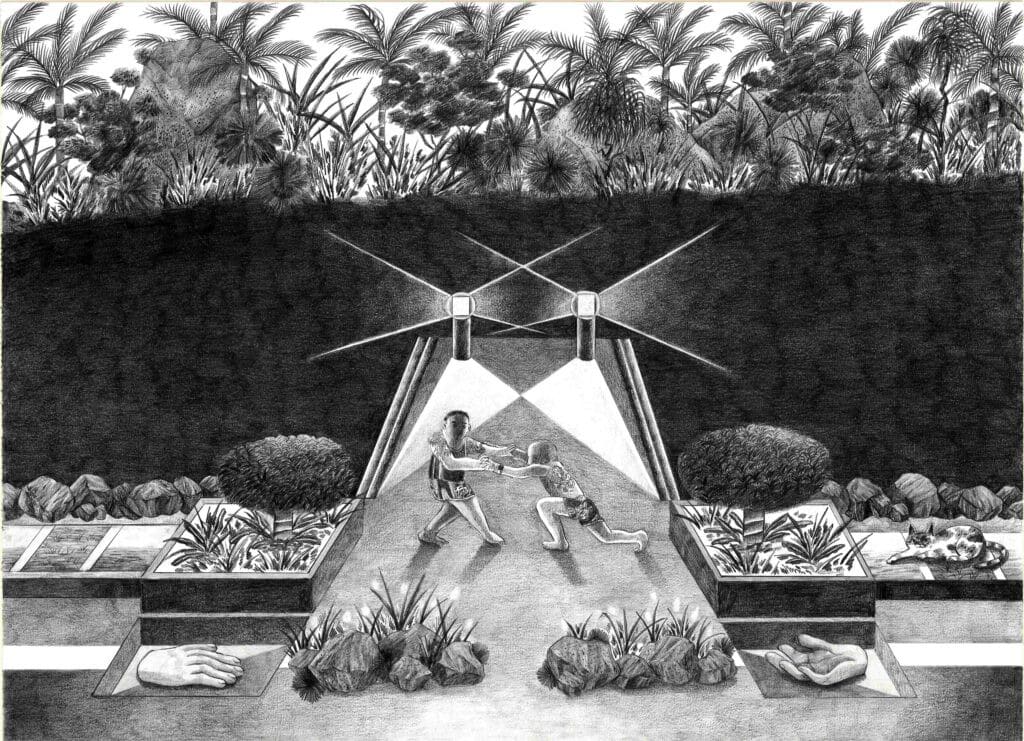
- This event has passed.
EVENT DESCRIPTION
White Cube is pleased to present ‘Half of a Yellow Sun’ by Ibrahim Mahama, his first exhibition in Hong Kong and Greater China. Featuring a selection of new fabric paintings, in these works Mahama explores the history of materials, commerce, and cultural identity.
The exhibition title is drawn from the novel of the same name by the Nigerian writer Chimamanda Ngozi Adichie, which focuses on the Nigerian-Biafran War in the late 1960s, while the individual works are inspired by the 1970s songs of Fela Kuti, the Pan-Africanist musician and political activist. For Mahama, this period of independence from colonial British rule across Africa has long been a source of inspiration. As the artist states: ‘this is an African story, with ideas of freedom beyond the chaos.’
The collaged sections of material in these works have been collected by Mahama over several years, through a process of exchanging new cloth for old from traders, mainly women, working in markets across Ghana. Known as ‘Dutch wax’ cloth, these densely patterned, colourful cotton fabrics were originally made and traded by Dutch companies operating along the coastal routes around West Africa in the 19th century.
Developed for export to the Dutch East Indian colonies, the fabrics, which incorporated traditional Indonesian batik design, were mass produced at a cheaper cost than authentic batik cloth; however, these products were shunned by customers in South East Asia, which led Dutch sellers to seek alternative markets. Stopping off for refuelling in West African port cities such as Accra, the Dutch trading vessels found a market for the imitation batik, which was soon modified to include African-inspired designs. Dutch wax cloth eventually became synonymous with African design and culture, often as a non-verbal means of communication within everyday wear, or to denote wealth, power, or influence in formal settings.
Many of the cloth swatches in Mahama’s paintings have names ascribed to their design, such as ‘Speed Bird’ (from the aphorism ‘rich today, poor tomorrow’, with reference to how money can easily ‘fly’ away), ‘Tortoise’ (to signify determination, strength, and patience) and ‘Eye’ (to mean that your wrongdoings will still be seen by Almighty God).
Another common design features a series of trees arranged in a crescent, resembling the shape and texture of the brain. This print, known as ‘Kofi Annan’s Brains’, was launched commercially on the day the Ghanaian Secretary-General of the United Nations gave his final address in New York which made reference to Annan’s intellectual prowess.
Mahama is interested in the political dimensions of the materials, and the forms of labour embedded within them. In post-colonial Africa, these fabrics represent a celebration of the diversity of national and pan- African identity; in bringing all these pieces together, Mahama is able to overlay different histories, cultural tropes, figurative and abstract forms as part of his ongoing investigation into the legacies of colonisation.
The development of this series is entwined with that of the jute sack works for which Mahama is best known. Gathering discarded fabric from various marketplaces in Ghana when he was an art student, Mahama began to build an extensive archive of materials. In the case of the jute, these eventually formed the basis for large-scale architectural interventions.
This current series using wax print samples, which Mahama had incorporated into some of his earlier works including Kwaku Minoona (2019) and Chale Wote (2014), are the culmination of an approach in which multiple remnants are juxtaposed and overlaid to produce unique, single works. In some, brightly coloured stitching between the sections appears as if inscribed or scribbled across the surface, while in others, patterns push out beyond the limits of the canvas frame. Mahama originally trained as a painter and the decisions made in these works – including in the selection of the fabrics, predicated on pattern and colour – he sees as akin to using paint on canvas.
ABOUT THE ARTIST / ORGANISER
Ibrahim Mahama was born in 1987 in Tamale, Ghana. He lives and works in Accra, Kumasi and Tamale. His work has appeared in numerous international exhibitions including NIRIN, 22nd Biennale of Sydney (2020); tomorrow, there will be more of us, Stellenbosch Triennale (2020); Future Genealogies, Tales From The Equatorial Line, 6th Lubumbashi Biennale, Democratic Republic of the Congo (2019); Parliament of Ghosts, The Whitworth, University of Manchester (2019); Ghana Freedom, inaugural Ghana pavilion, 58th Venice Biennale, Venice (2019); Labour of Many, Norval Foundation, Cape Town (2019); Documenta 14, Athens and Kassel (2017); All the World’s Futures, 56th Venice Biennale, Venice (2015); Artist’s Rooms, K21, Düsseldorf (2015); Material Effects, The Broad Art Museum, Michigan (2015); An Age of Our Own Making, Kunsthal Charlottenborg, Copenhagen and Holbæk (2016) and Fracture, Tel Aviv Art Museum, Israel (2016). In March 2019, Ibrahim Mahama opened the artist-run project space Savannah Centre for Contemporary Art (SCCA) in Tamale, Ghana, followed by the opening of a vast studio complex, Red Clay, in nearby Janna Kpeŋŋ in September 2020. Encompassing exhibition space, research facilities and an artist-residency hub, both sites represent Mahama's contribution towards the development and expansion of the contemporary art scene in his home country. In April 2021, Mahama opened a renovated silo, Nkrumah Volini, in Tamale. This is the third educational institution he has opened in Northern Ghana since over the past two years.Organiser
You may also like
Leave a Reply Cancel reply
You must be logged in to post a comment.



